Symbols of Spirit – February 2024
CADA Curator: Ludlow Bailey
The Arthur B. Steiman and The Paul and Mary Rosen collections of Central and West African masks serve as a rich tapestry, unraveling the intricate layers of spiritual symbolism embedded in these powerful artifacts. These masks, often regarded as expressions of deities and spiritual forces, provide a glimpse into the profound theological and cosmological systems that operate beyond the confines of logic and rationality.
At the heart of these masks lies an unfathomable connection to the spiritual realm. Carved with meticulous detail and infused with symbolism, each mask becomes a conduit for divine energies and cosmic forces. The choice of materials, the symbolism of colors, and the distinctive features of each mask contribute to a narrative that transcends the physical world, inviting viewers into a dimension where spirituality takes tangible form.
In Central and West African cultures, these masks play a pivotal role in ceremonial rituals, acting as intermediaries between the human and spirit realms. They are not mere artistic expressions but vessels through which the unseen forces of the cosmos manifest. The exaggerated features, bold patterns, and intricate designs on the masks are not arbitrary; instead, they encode a language of spiritual significance, conveying messages to those attuned to the sacred narratives.
Furthermore, these masks are integral to communal practices that bind societies together. Through dance, music, and performance, the spiritual essence of the masks is brought to life, creating a collective experience that transcends individual perspectives. The rituals associated with these masks reinforce social cohesion and affirm the interconnectedness of the community with the spiritual forces that guide and protect them.
Both collections include masks originating from influential tribes such as the Chokwe, Kuba Kingdom, Bobo Fing, Ligbi, Yoruba, Ogoni, Dan Yakuba, Voltaic, Senufu, Baule, Songe, Fang, Bobo Bwa, Igbo, Kwele, Luba, Janiform, Guro, Mama People, Bete, Kulango, Lega, Lwala, and Punu, coming from countries like Nigeria, Congo, and the Ivory Coast.
Both collections also offer a diverse array of masks, each representing a unique facet of the spiritual landscape. From masks associated with fertility rites to those linked with ancestral veneration, the collection highlights the multiplicity of spiritual dimensions within Central and West African cultures. As viewers engage with these artifacts, they are invited to contemplate the intricate web of beliefs that underpin the spiritual worldview of these societies.
Masks in Collection Wall Text – Symbols of Spirit
Chokwe Wood Mask (Angola) – Rosen Collection
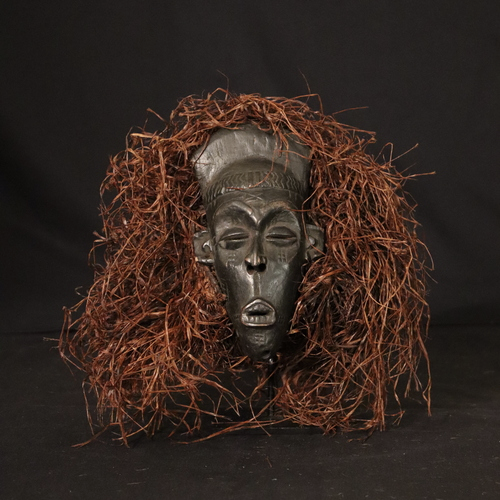
Originating from Angola, this Chokwe wood mask embodies the cultural traditions of the Chokwe people. Crafted with intricate detail, it serves as a passport mask, used for identification purposes during travel and initiation ceremonies.
The mask showcases scarification marks on the cheeks, known as tukone, which hold significance within Chokwe society for ancestral connections and tribal affiliations.
The Chokwe people have a long history of artistic expression, with masks serving as vital elements in their rituals and ceremonies. The masks are symbols of cultural identity and spiritual significance, representing the collective memory and ancestral lineage of the Chokwe community. Through intricate craftsmanship and symbolic motifs, Chokwe masks convey a profound sense of connection to tradition and heritage, inviting viewers to delve deeper into the cultural tapestry of the Chokwe people.
Kuba Helmet Mask (Democratic Republic of the Congo) – Steinman Collection
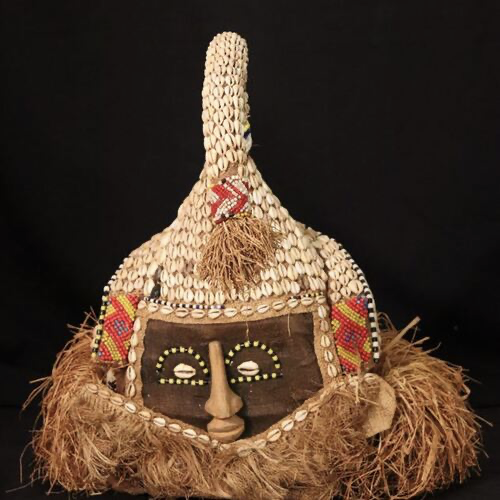
This intricate mask, hailing from the Democratic Republic of the Congo, reflects the rich cultural heritage of the Kuba Kingdom. Crafted with geometric designs, cowrie shells, and vegetable fiber, it is worn by men of royal descent during coronation rituals or chief installations. The elephant motif adorning the mask symbolizes strength, financial prosperity, and the royal wealth amassed through ivory trade.
The Kuba people have a long history of artistic expression and intricate craftsmanship, with masks playing a central role in their ceremonial traditions and social structure. These masks are not mere adornments; they are symbols of power and prestige, reflecting the Kuba people’s reverence for their kingship and cultural heritage. Through their elaborate designs and symbolic meanings, Kuba masks convey a sense of pride and tradition, inviting viewers to appreciate the beauty and complexity of Kuba artistry.
Bobo Fing People Doyo Society Plank Masks (Burkina Faso) – Steinman Collection
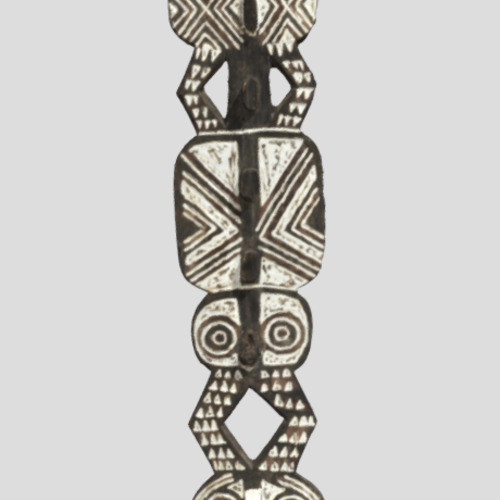
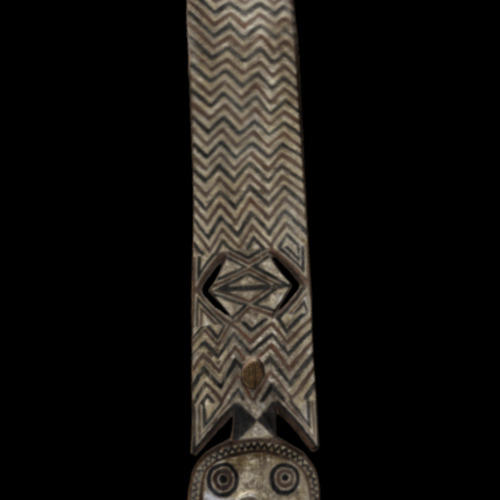
Originating from Burkina Faso, these large carved wood masks feature rounded faces with a handle, typical of masks used in Doyo Society rituals. Adorned with brown and black vegetable pigment, brown indigo, and white kaolin, they embody the cultural and ceremonial significance of the Bobo Fing people, emphasizing kinship and clan systems. The Bobo Fing people have a strong sense of community and traditional values, with masks serving as vital instruments for spiritual connection and social cohesion.
These masks are embodiments of Bobo Fing identity and cultural heritage, representing the collective spirit and ancestral lineage of the community. Through their elaborate designs and ceremonial use, Doyo Society masks play a central role in preserving the traditions and values of the Bobo Fing, ensuring their continuity for future generations.
Ligbi People Ceremonial Dance Mask (Côte d’Ivoire) – Steinman Collection
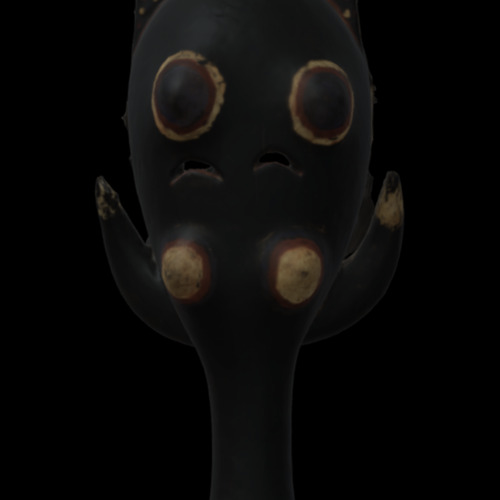
This warthog head mask, crafted with meticulous detail, features cleverly positioned cutouts for the wearer’s eyes, enhancing visibility during ceremonial dances. Constructed from carved wood, it boasts a striking patina of black vegetable pigment accented by white kaolin, blue indigo, and red earth pigment. Remnants of indigenous fabric adorn the mask, secured through carefully placed holes around its perimeter. The presence of these fabric remnants suggests a history of use and reverence within Ligbi ceremonial traditions.
Notably, the Ligbi people, while predominantly Muslim, incorporate indigenous customs and beliefs into their ceremonies, illustrating a harmonious synthesis of Islamic and traditional African practices deeply rooted in their cultural heritage.
Dan Yakuba People Poro Society Ceremonial Bird Mask (Côte d’Ivoire) – Steinman Collection
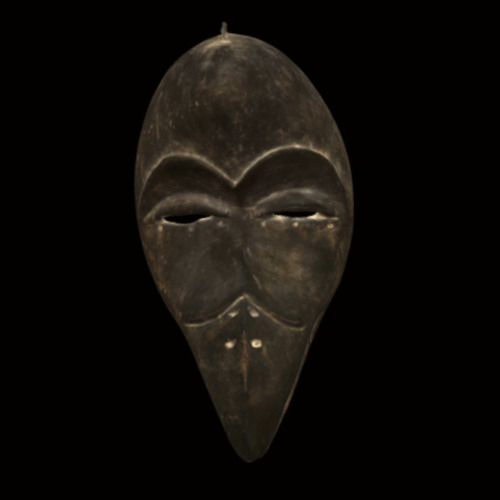
This striking bird-themed mask, originating from the Ivory Coast, is associated with the Poro Society, a secretive male group responsible for conducting funerals and other rituals among the Dan Yakuba people. Carved from wood with a dark brown patina, it features a beak, four nostrils, and a carved red-brown tongue, symbolizing spiritual connections and ancestral reverence.
The Dan Yakuba people hold deep respect for their cultural traditions and the Poro Society’s role in preserving their spiritual heritage, with masks serving as powerful symbols of identity and collective memory.
These masks are embodiments of Dan Yakuba spirituality and cultural identity, representing the sacred bond between the community and its ancestors. Through their intricate designs and ritualistic use, the masks evoke a sense of reverence and awe, inviting viewers to explore the mysteries of their cultural heritage and spiritual beliefs.
Voltaic Mask (Burkina Faso) – Rosen Collection
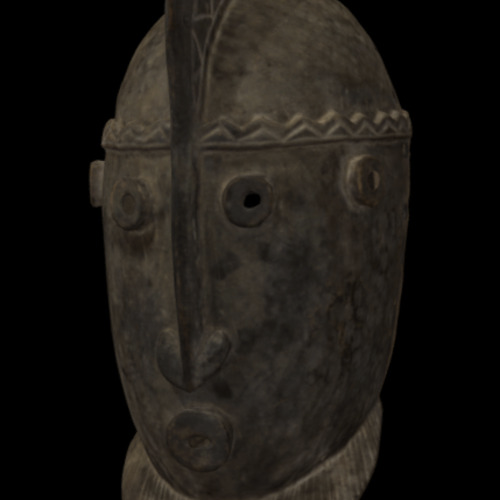
Characterized by a hand grip, beard, small mouth, four eyes, and a crest, this Voltaic mask embodies the intricate craftsmanship and symbolic significance of masks in various rituals, including those related to farming, funeral commemorations, and annual ceremonies honoring ancestral spirits.
The term Voltaic refers to a broad linguistic and cultural classification rather than a specific ethnic group. Crafted by communities spanning Burkina Faso, northern Ghana, northern Côte d’Ivoire, Togo, and parts of Mali, Voltaic masks play a vital role in ceremonies, festivals, and social rituals, serving as conduits for spiritual connection and cultural preservation.
Artistic expression varies widely among the Voltaic peoples, including mask-making, pottery, weaving, and metalwork. These crafts are not only utilitarian but also hold cultural and religious significance, often being integral to ceremonies, festivals, and social rituals.
Senufo Mask (Northern Côte d’Ivoire) – Rosen Collection
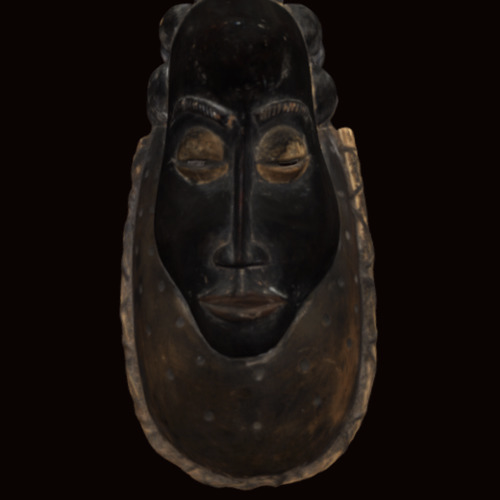
The Senufo people’s masking tradition is influenced by the Poro Society, a secret male group who organize and conduct funerals of the Senufo people. At funeral ceremonies, spirit masks emerge from the forest to escort the soul of the deceased to its final resting place. Masks are also used for agricultural celebrations and conflict resolution. Features include an elongated nose, sharp horizontal brow, pattern of scarification and bird crest.
The Senufo people have a strong sense of community and social cohesion, with masks serving as potent symbols of cultural identity, spiritual protection, and collective heritage.
Chokwe Mask (Angola) – Rosen Collection
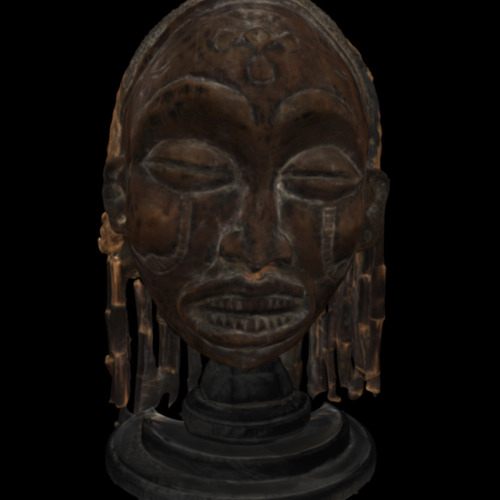
This Chokwe mask from Angola depicts a woman, called Mwanapwo. A defining feature of many Chokwe masks is an exaggerated bone structure and broad mouth. The scarification in the center of the forehead is referred to as chingeleyele, a symbol based on the Maltese cross brought by the Portuguese who colonized Angola in 1575. The Chokwe have had an artistic influence on their neighbors including the Luanda, Luvale, and Mbangani peoples.
Masks are significant in Chokwe culture, used in initiation ceremonies, social control, and entertainment. These masks represent various characters, including ancestral figures and animals, playing a critical role in communicating the tribe’s mythology and moral values.
Ogoni People Zoomorphic Ceremonial Dance Mask (Nigeria) – Steinman Collection
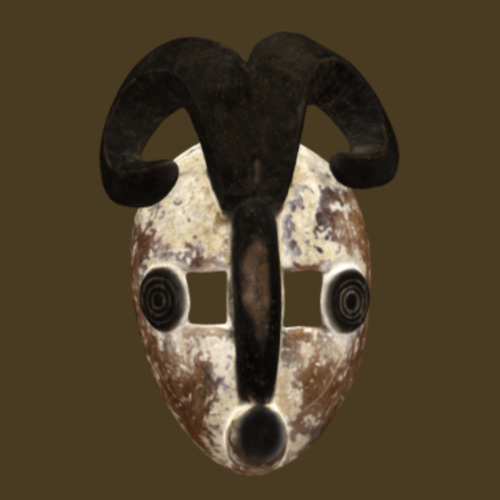
This oval-shaped mask, originating from Nigeria, embodies the artistic ingenuity of the Ogoni people. Featuring large eye openings and elegantly curled ram horns, it is carved from wood with a natural light brown patina, white kaolin, and dark brown vegetable pigment.
Used in ceremonial dances, this mask represents the Ogoni people’s cultural heritage and spiritual connections to the natural world. The Ogoni people have a deep reverence for nature and the ancestral spirits, with masks serving as sacred objects of worship and conduits for spiritual communion.
These masks embody Ogoni spirituality and cultural identity, representing the community’s enduring bond with the land and its traditions. Through their intricate designs and ceremonial significance, Ogoni masks evoke a sense of awe and reverence, inviting viewers to connect with the spiritual essence of Ogoni culture.
Baule People Goli Dance Mask (Côte d’Ivoire) – Steinman Collection
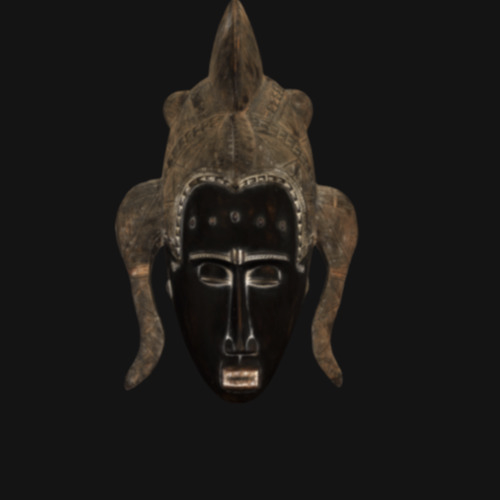
This oval-shaped mask is crafted from carved wood and adorned with a rich dark brown vegetable pigment patina. It represents a female face with an elaborate coiffure and free-form braids, while the holes around the rim indicate its practical use in Goli performances.
The Baule Goli rituals serve as a form of entertainment and cultural expression, allowing community members to showcase their artistic talents through music, dance, and elaborate costumes. Along with their use in entertainment, masks such as this are employed in invoking protection, warding off malevolent forces, and fostering communal cohesion.
Songe Wood Face Mask (Democratic Republic of the Congo) – Rosen Collection
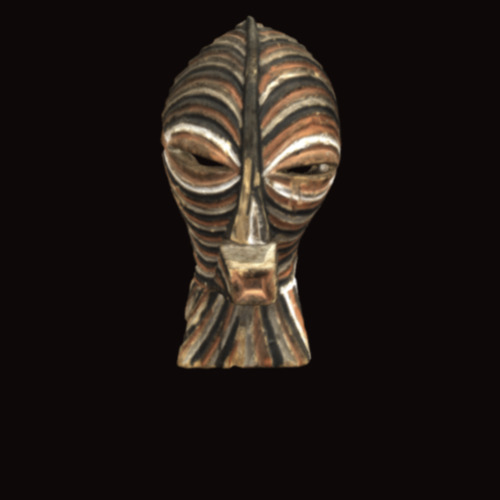
Originating from the Democratic Republic of the Congo, this wood mask embodies the Songe people’s reverence for the moon and celestial forces. Characterized by grooved striations and symbolic white markings, it is worn during lunar ceremonies, investitures, or the passing of tribal rulers, symbolizing spiritual connections and ancestral guidance.
The Songe people have a deep spiritual connection with the cosmos and the natural world, with masks serving as channels for communicating with the divine and honoring their ancestral lineage. These masks are vessels of Songe spirituality and cultural heritage, representing the community’s profound connection to the celestial realm. Through their symbolic imagery and ceremonial significance, Songe masks invite viewers to contemplate the mysteries of the universe and the timeless wisdom of Songe tradition.
Fang People Ceremonial Dance Mask (Equatorial Guinea) – Steinman Collection
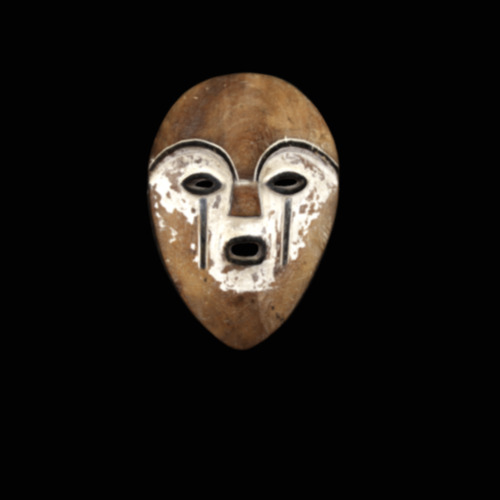
Crafted from carved wood with a striking variation of light and dark brown patina complemented by white kaolin, this heart-shaped mask reflects the cultural practices of the Fang people.
Masks hold profound significance within Fang secret societies, particularly the Ngil masks, donned by male members during nocturnal ceremonies. These rituals serve dual purposes: the initiation of new society members and the punishment of transgressors. Through intricate ceremonies performed under the cloak of darkness, the Fang people reinforce social cohesion, spiritual connections, and the preservation of their cultural heritage, illustrating the profound role of masks in Fang society.
The intricate carving and symbolic coloration represents more than just a mere disguise; it embodies the collective identity, spiritual beliefs, and communal values of the Fang people, passed down through generations in their rich tradition of masking practices.
Kwele People Ceremonial Dance Mask (Republic of the Congo) – Steinman Collection
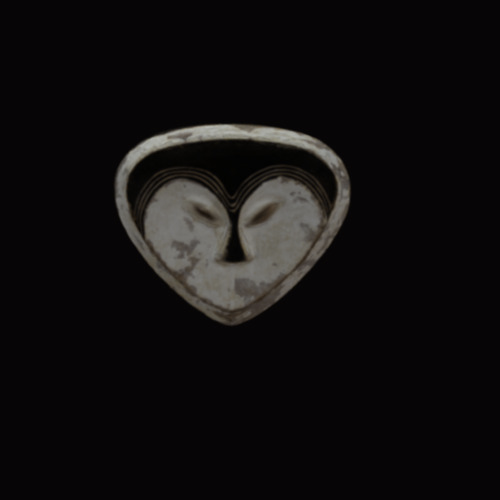
This heart-shaped mask is carved from wood with brown patina and white kaolin, featuring angled slit eyes and three-lined eyebrows, symbolizing spiritual connections and ritualistic practices within Kwele society.
The Kwele people have a rich cultural heritage, with masks playing a central role in traditional ceremonies and rites of passage, serving as vessels for invoking ancestral spirits and divine blessings. These masks serve as conduits of Kwele spirituality and cultural expression, representing the community’s profound connection to its ancestral lineage. Through their intricate designs and ceremonial significance, Kwele masks invite viewers to explore the depths of Kwele culture and tradition, offering glimpses into a world of spiritual wisdom and communal harmony.
Luba People Kiefwebe Society Ceremonial Mask (Democratic Republic of the Congo) – Steinman Collection
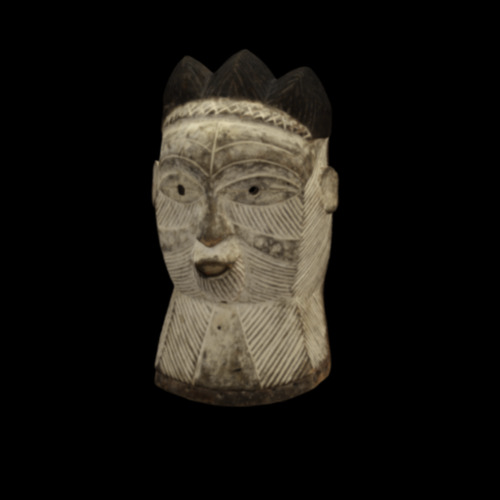
This distinctive mask, hailing from the Democratic Republic of the Congo, represents a man’s face and serves ceremonial purposes within the Luba people’s Kiefwebe Society.
Carved from wood with dark brown vegetable pigment and white kaolin, it features intricate detailing and a three-part coiffure, embodying spiritual authority and cultural significance in Luba society.
The Luba people have a deep respect for their cultural heritage and societal structures, with masks serving as symbols of power, wisdom, and ancestral lineage. These masks are embodiments of Luba spirituality and social hierarchy, representing the community’s reverence for its ancestral traditions. Through their symbolic imagery and ritualistic use, Luba masks offer insights into the complex social dynamics and spiritual beliefs of Luba society.
Kono Wood Janiform Mask (Côte d’Ivoire) – Rosen Collection

This janiform mask from the Ivory Coast features two tapering heads and finely engraved coiffure lines on a darkened surface. A janiform mask bears two faces looking in opposite directions.
With rich patina and intricate bird motifs, it represents the Kono society’s ritualistic practices and agricultural ceremonies, invoking spiritual blessings for a successful harvest.
The Kono people have a deep connection to the land and agricultural cycles, with masks serving as symbols of fertility, abundance, and communal harmony in their traditional way of life. These masks are integral to Kono society, embodying the spiritual essence of the community and serving as mediators between the human and spiritual realms. Through their use in ceremonies and rituals, Kono masks reinforce the bonds between individuals and their ancestral heritage, ensuring the continuity of cultural practices and the prosperity of future generations.
Fang People Ceremonial Dance Mask (Equatorial Guinea) – Steinman Collection
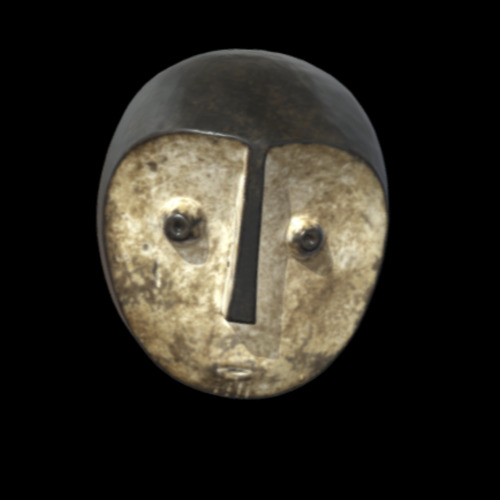
This round mask is carved from wood with a dark brown patina and white kaolin, it features a rounded monkey’s face with minimal features, representing spiritual entities associated with secret societies and initiation rituals among the Fang community.
The Fang people have a strong tradition of ritualistic practices and communal rites, with masks serving as powerful symbols of spiritual protection and social cohesion. These masks represent the community’s deep connection to its ancestral traditions. Through their symbolic imagery and ceremonial use, Fang masks evoke a sense of mystery and reverence.
Bobo Bwa People Zoomorphic Ceremonial Mask (Burkina Faso) – Steinman Collection
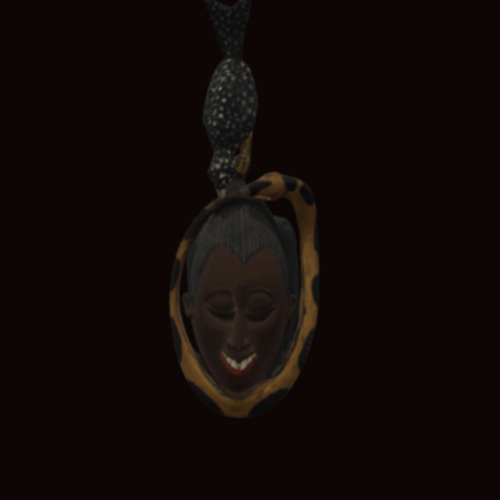
This zoomorphic mask from Burkina Faso portrays a feminine face framed by a spotted snake and adorned with a duck figure above the head, typifying the artistic traditions of the Bobo Bwa people. Carved from wood with dark brown and black pigments and white kaolin, it is used in ceremonial rituals, invoking spiritual connections and ancestral blessings for the community.
The Bobo Bwa people have a deep connection to the natural world and the animal kingdom, with masks serving as embodiments of their reverence for nature and the spiritual forces that govern their lives. These masks are conduits of Bobo Bwa spirituality and cultural identity, representing the community’s intimate relationship with the land and its wildlife.
Through their intricate designs and ceremonial use, Bobo Bwa masks offer glimpses into the sacred rituals and spiritual beliefs that have shaped their culture for centuries.
Igbo People Ceremonial Dance Mask (Nigeria) – Steinman Collection
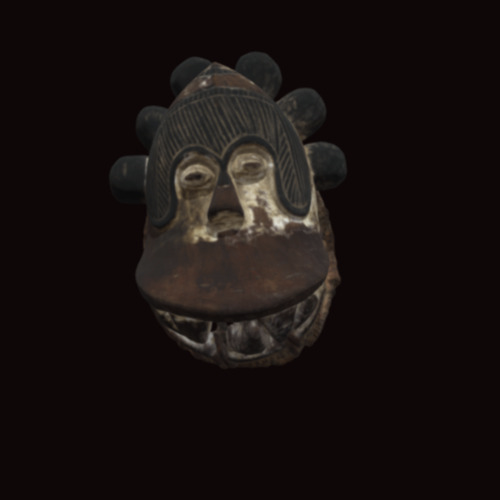
Here we see the striking visage of the Igbo ceremonial dance mask, a captivating embodiment of the Igbo people’s spiritual and artistic expression. Carved from wood and adorned with light and dark brown patina and white kaolin, this mask exemplifies the Igbo’s masterful craftsmanship and profound symbolic language.
The mask’s presence here invites us to traverse boundaries and enter a world where art converges with the sacred, where every dance step is a testament to cultural endurance and collective identity. As you gaze upon this artifact, consider the pulsating rhythms, the vibrant movements, and the communal bonds that such a mask reinforces and celebrates.
This Igbo dance mask is not only a treasure of African artistry; it is a portal to the rich tapestry of Igbo culture—a culture that continues to dance vibrantly at the crossroads of tradition and modernity.
Yoruba People Ceremonial Dance Mask (Nigeria) – Steinman Collection
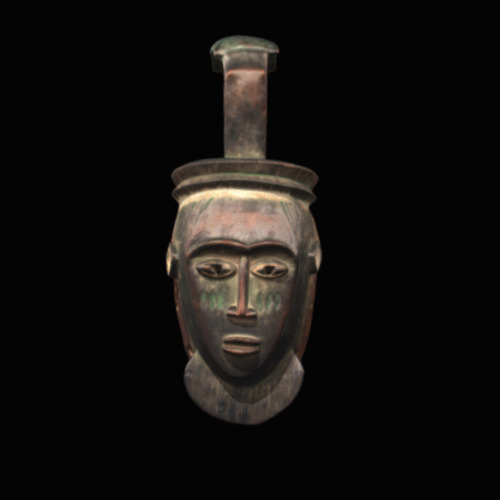
This Yoruba ceremonial dance mask acts as a sacred conduit between the spiritual and terrestrial realms. This artifact, sculpted from indigenous wood, is steeped in the profound artistic traditions of the Yoruba people of Nigeria.
Observe the poised, tranquil features: the almond-shaped eyes, the gentle curve of the lips, and the smooth contours of the face, which come together in a visage of peace and introspection. The vertical projection atop the mask, signifies a connection to the spiritual power of ase communicating with the divine.
The mask is accentuated with indigenous pigments, highlighting its features and imbuing it with earthy vitality. In the masquerade, this mask comes alive, not only an object of aesthetic admiration but a dynamic participant in Yoruba religious and cultural life. It is worn in dance to honor deities and ancestors, to teach, to entertain, and to imbue the wearer with the powers it represents.
Dan Yakuba People Poro Society Fire Runner Mask (Côte d’Ivoire) – Steinman Collection
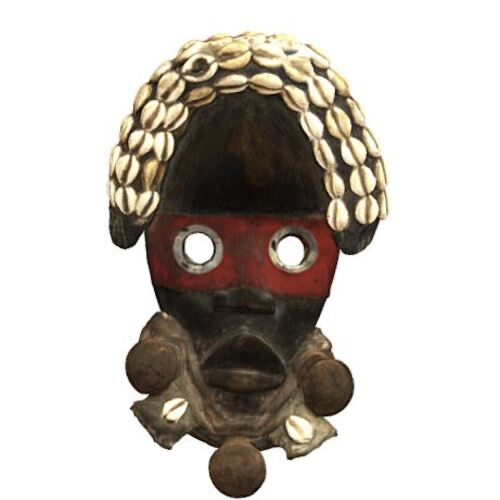
This mask of the Dan Yakuba is not a disguise but a place of personal identity. This Fire Runner Mask, represents a mesmerizing fusion of art, spirituality, and community.
Adorned with cowrie shells, the mask features bold, contrasting colors: the stark white of purity, the deep black of the earth, and the vibrant red that speaks of fire and transformation. The mask’s round, protruding eyes, are windows to the spiritual world, allowing the wearer to see beyond the physical realm.
Worn by the fire runner, this mask is animated during the Poro Society’s ceremonies. As the fire runner moves, the mask becomes an expression of the society’s teachings, promoting social values and instructing the community through performance.
This mask invites you to contemplate the rich tapestry of the Dan Yakuba’s cultural heritage—a heritage where artistry serves as a bridge to the divine, and where every dance is a step through the annals of ancestral wisdom.
Baule People Double Face Ceremonial Dance Mask (Côte d’Ivoire) – Steinman Collection
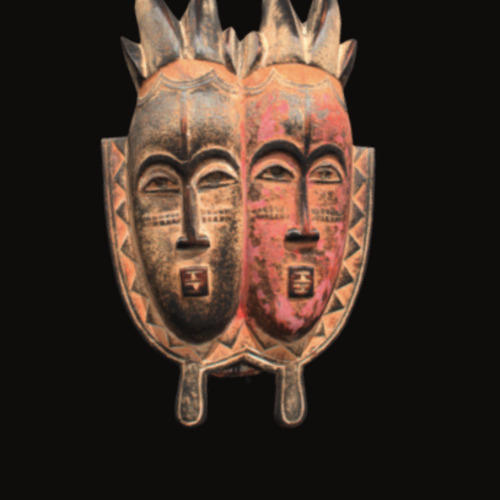
Crafted by the Baule people of the Ivory Coast, this artifact is a profound testament to the complexity and balance of human nature, representing the twin spirits believed to inhabit the spiritual realm parallel to our own.
The mask’s symmetry and harmonious features celebrate the Baule’s aesthetic values and their belief in beauty as a reflection of inner virtue. The serene expressions, highlighted with earth-toned pigments, embody the Baule’s deep connection to the land and their ancestors. The two faces suggest a thematic dualism, possibly evoking the Baule’s philosophical explorations of gender, morality, or the link between the earthly and the divine.
In ceremonial dances, this mask transcends its wooden form, coming alive with each rhythmic movement, each beat of the drum, allowing the wearer to mediate between worlds, invoking blessings, and weaving the fabric of the social and spiritual life.
Guro People Ceremonial Dance Mask (Côte d’Ivoire) – Steinman Collection
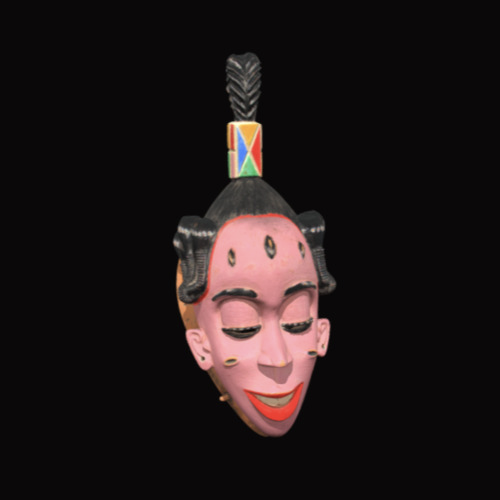
This Guro ceremonial mask embodies the idealized beauty and poise of the feminine spirit, in the dance known as “Zaouli.” Adorned with a vibrant palette, from the lustrous black hair to the radiant red lips, it reflects the Guro’s mastery of transforming wood into a canvas of cultural storytelling. Downcast eyes, rimmed with meticulous black, evoke a sense of introspection and serenity, while the facial scarification marks signify identity and social standing. The hairstyle and the geometric motif atop signify social status and are entwined with the Guro’s mythology and cosmology.
In the swirl of the dance, this mask takes on a life of its own, embodying the spirit it represents, inspiring joy and evoking the protective gaze of the ancestors. It serves as a medium for education, as each performance is an opportunity to impart wisdom and celebrate the Guro’s harmonious relationship with the natural world.
This mask, in its polychromatic elegance, is a testament to the Guro’s philosophy that art is a bridge to the divine, a medium for storytelling, and a vibrant thread in the fabric of cultural identity.
Baule Wood Face Mask (Côte d’Ivoire) – Rosen Collection
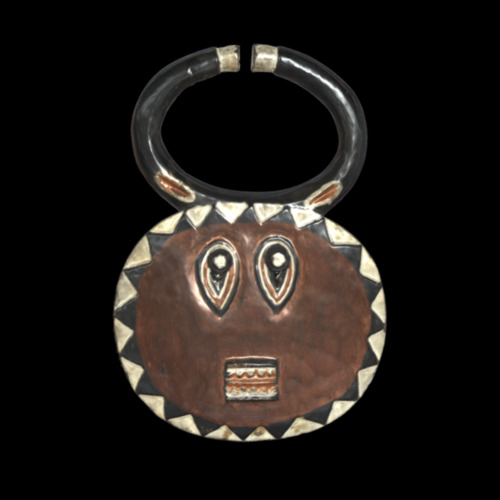
The Goli Wooden Face Mask from the Baule people is celebrated for its unique form and spiritual significance. This mask, characterized by its expressive features and geometric patterns, plays a central role in the Goli ritual—a dance that is both a spectacle and a profound spiritual exercise, serving to appease and entertain various deities.
The mask’s circular face and the halo-like structure symbolize the cyclical nature of life. The contrasting geometric patterns symbolize the balance between order and chaos, the physical and the metaphysical. The white and black triangles around the mask’s edge represent the duality of existence—joy and sorrow, day and night, life and death.
Traditionally, the Goli dance is a visual narrative with the mask’s wearer channeling the spirit it represents to connect the Baule people with the transcendent. The mask lets us consider the timeless human endeavor in understanding our place in the universe, an endeavor as relevant today.
Mama People Anthropomorphic Ceremonial Mask (Nigeria) – Steinman Collection
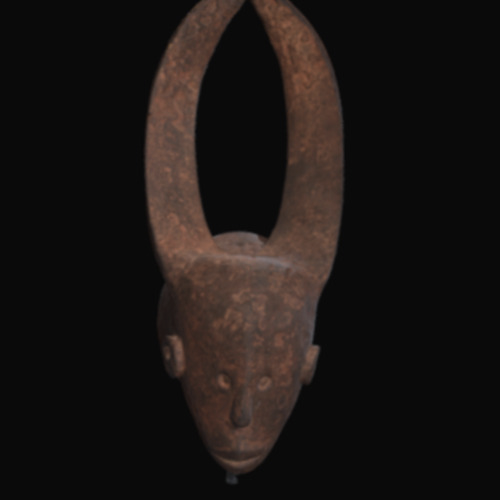
This enigmatic Anthropomorphic Ceremonial Mask of the Mama people, hailing from the savannas of Northwestern Nigeria, embodies the intersection of the human and the animal, the earthly and the divine.
Carved from a single piece of wood, the mask captures the essence of the Mama’s spiritual beliefs, where animals are seen as guides between the worlds. The elongated form is a testament to the artistic ingenuity and spiritual insight of its creators. The intricate scarification patterns etched on the surface mirror those found on the bodies of Mama warriors, signifying strength, courage, and social identity.
This mask is traditionally used in ceremonial dances, often during harvest festivals and rites of passage, where it serves as a conduit for ancestral spirits and a medium through which the community seeks guidance and blessings. The wearer of the mask transcends their human form, becoming a living embodiment of the tribe’s ancestral heritage and collective memory.
Bete People Ceremonial Dance Mask (Côte d’Ivoire) – Steinman Collection
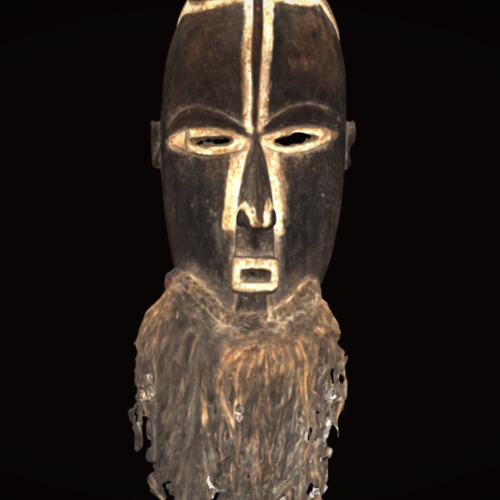
This striking Bete mask, with its fierce expression and imposing beard, is a masterpiece of Ivory Coast artistry. Known to harness the wild beauty of nature, the Bete people create masks that are both a shield and a channel, worn by warriors and dancers to communicate with the spirit world during ceremonial dances.
The mask, carved from dense wood and accentuated by metal teeth, is a testament to the Bete’s skillful craftsmanship. The dark patina suggests the use of natural dyes and highlights of white kaolin, while the beard, made of woven rope and raffia, adds an element of the untamed wilderness, to which the Bete are deeply connected.
In the Bete cosmology, such masks are not mere representations; they are imbued with spiritual energy, transforming the wearer and enabling them to embody the valor needed to confront malevolent spirits. The mask’s intense gaze and stern mouth are deliberate, designed to inspire awe and respect.
Kulango People Ceremonial Dance Mask (Côte d’Ivoire) – Steinman Collection
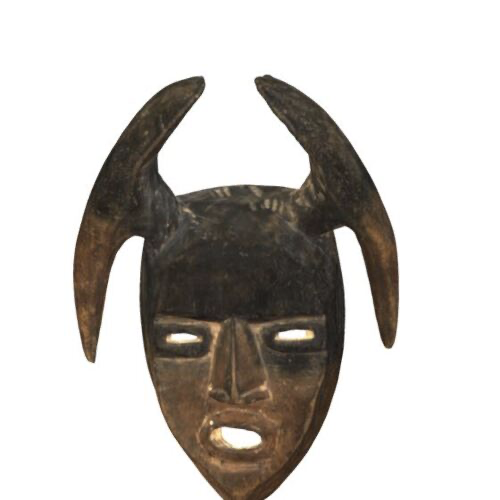
This Ceremonial Dance Mask of the Kulango, originating from the Ivory Coast and Burkina Faso, is a profound representation of the Kulango’s connection to both the earthly and the supernatural.
The mask, characterized by the striking presence of horns of the buffalo, symbolizes the forces of nature often depicted in Kulango mythology. Horns are a symbol of power and are believed to grant the wearer the ability to connect with powerful animal spirits during ceremonies.
The mask conveys a sense of enigmatic wisdom. Its narrowed eyes and open mouth are traditional design elements that invite onlookers to ponder the mysteries of Kulango cosmology. In ceremonial dances, it becomes a medium for storytelling, education, and communal bonding, as well as a protective emblem against malevolent forces.
This mask is a key to understanding the rich tapestry of Kulango beliefs—a culture that reveres the dance between humans, the environment, and the spiritual world.
Senufo People Kepele Ceremonial Dance Mask (Côte d’Ivoire) – Steinman Collection
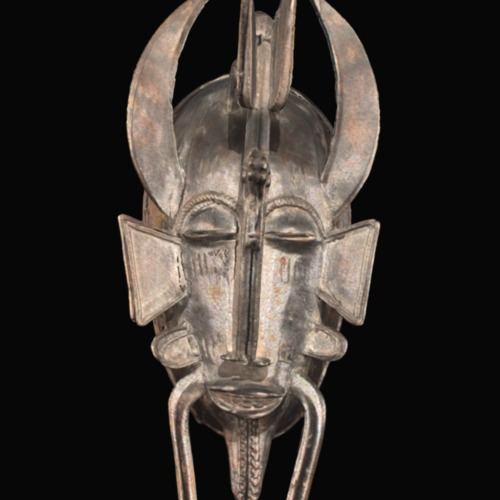
The Kepele mask stands as a profound expression of the Senufo people of West Africa and their spiritual reverence. This ceremonial dance mask, with its elongated form and symmetrical features, is a testament to the Senufo’s craftsmanship and their connection to the animal kingdom.
The mask’s serene face, flanked by protruding ears, represents calm wisdom, while the graceful arched horns symbolize strength and fertility. The elongated nose bridge that unites the horns signifies unity and the bridge between the earthly and the celestial.
A one-of-a-kind bronze made by lost wax casting, this Kepele mask is used in performances that are integral to Senufo funeral rites and harvest celebrations. It dances to the beat of drums, embodying ancestral spirits and delivering messages from the beyond, guiding the community through cycles of life and death.
Djimini-Senufo People Hand-held Ceremonial Mask (Côte d’Ivoire) – Steinman Collection
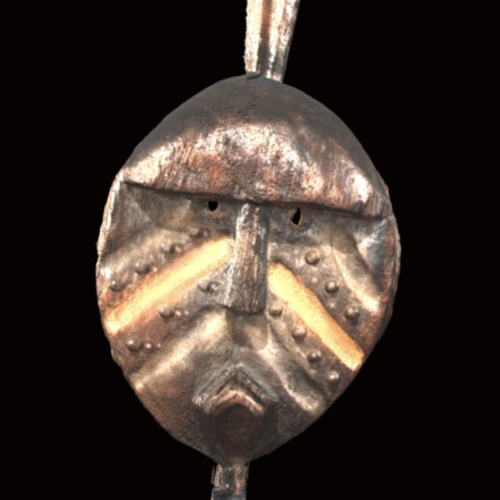
This hand-held ceremonial mask, crafted by the Djimini, an offshoot of the Senufo people, is a profound emblem of protection and communal unity. The Djimini-Senufo, renowned for their spiritual artistry, create masks that are not solely objects but participants in the sacred ceremonies that stitch the fabric of their society.
The mask’s face, with its muted earth tones and bold, ochre accents, displays a powerful symmetry. The central ridge divides the mask into two balanced halves, echoing the Senufo belief in harmony and duality. Its surface is adorned with raised nodules and incised lines, creating a textured landscape that invites touch and signifies the mask’s active use in ritual life.
In use, the mask is a mobile altar, a focal point for prayer and meditation during significant communal gatherings. It is believed to have the power to connect the physical world with the ancestral realm, guiding the Djimini-Senufo people in decisions, healing, and rites of passage.
Lega People Bwami Society Rank Mask (Democratic Republic of the Congo) – Steinman Collection
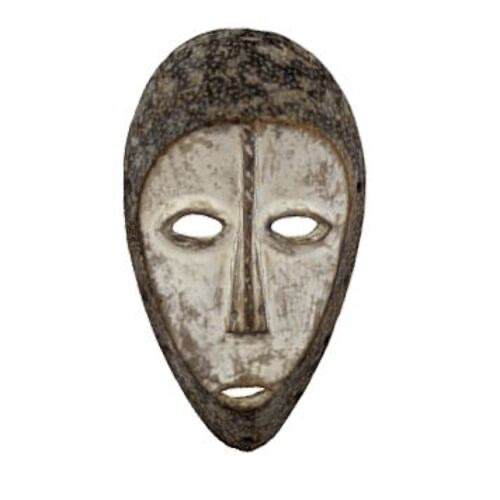
This mask is a symbol of the Bwami society of the Lega people, embodying the moral values central to Lega culture. The Bwami society utilizes such masks in the instruction and initiation of its members.
Crafted from wood and adorned with a patina of kaolin clay, the mask’s face is a canvas for contemplation and reverence. The simplicity of its form—sober eyes, a straight, narrow nose, and a mouth set in quietude—reflects the Lega’s esteem for wisdom and restraint.
Each mask is unique, its features revealing the rank of the wearer within this complex hierarchy. The Lega people live in a community that governs itself and has levels of ranking for inhabitants. In Lega philosophy, the mask is both a didactic tool and a spiritual object, its presence in ceremonies reinforcing the societal ideals of harmony, respect, and community.
Lwala People Ceremonial Dance Mask (Democratic Republic of the Congo) – Steinman Collection
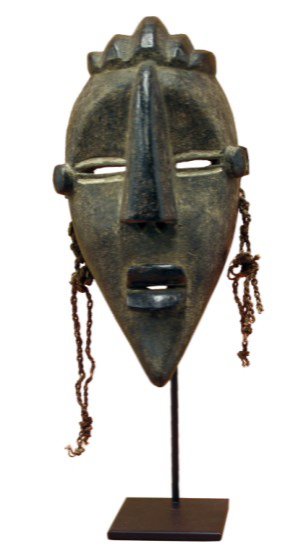
This ceremonial dance mask of the Lwala people of the Democratic Republic of Congo, stands as a sentinel of tradition and cultural expression.This mask has watched over countless ceremonies, its stoic face a silent guardian of Lwala lore.
The mask’s features are carved with bold definition, from the pronounced, ridged crown symbolizing authority and connection to the divine, to the piercing gaze of its coffee bean-shaped eyes. These eyes, carved through the wood, allow the wearer to see yet remain concealed, embodying the dual nature of visibility and mystery. The mouth, set in an austere line, suggests the mask’s role in serious ceremonial functions, perhaps speaking without words to convey the wisdom of ancestors.
Adorned with metal accents and flanked by braided fiber ropes, the mask is transformed during the dance, its materials merging human craftsmanship with natural elements to evoke the Lwala’s deep respect for the land that sustains them.
Punu People Ceremonial Dance Mask (Gabon) – Steinman Collection
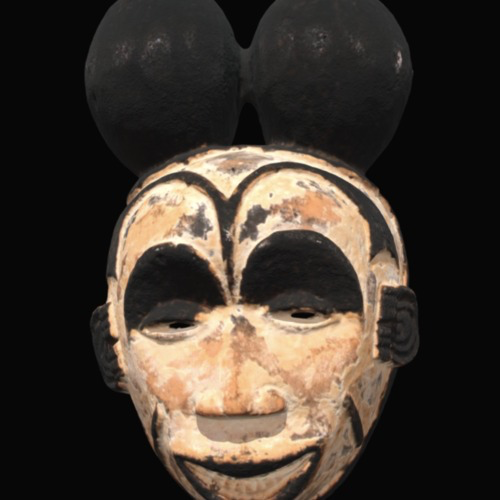
The Punu people’s reverence for the ancestral realm is symbolized in this ceremonial dance mask. Used in the sacred Okuyi funeral ceremonies, this mask captures the visage of a female ancestor, guiding the living through the delicate threshold between worlds.
The mask’s white pigment is the color of the spirits, representing purity and the afterlife. The black detailing and the heart-shaped face are hallmarks of Punu artistry, celebrating feminine beauty and the wisdom of the deceased. The dual spherical forms at the crown echo traditional Punu hairstyles, symbolizing the vitality of the ancestor it embodies.
During the funeral ceremony, the mask comes to life, not merely an object but a bridge to the past. It is danced to mourn, to honor, and to ensure the spirit’s peaceful transition to the afterworld. This is not just a tribute to an individual soul; it is a collective embrace of heritage, an expression of communal memory and identity.
Yoruba Gelede Wood Mask (Nigeria) – Rosen Collection
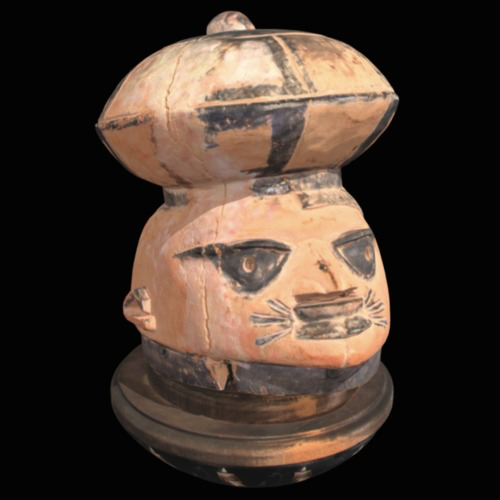
This Yoruba Wood Gelede Mask from Nigeria is a sculptural ode to the power and influence of women within the Yoruba community. The Gelede festival celebrates the dual qualities of nurturing and discipline embodied by these respected matriarchs.
Crafted with an eye for symbolism, the mask features a superstructure that resembles a “Gele,” a head tie part of women’s attire in Yoruba culture, representing social status and sophistication. Below, the serene face of the mask is adorned with scarification marks, echoing the beauty standards and identity markers significant to the Yoruba people.
The mask is worn during dancing, singing and drumming. The mask’s wearer, through the art of performance, channels the spirit of “Aje,” bringing to life the principles of harmony, wisdom, and moral authority. The colors, patterns, and form of this mask are a visual lexicon of Yoruba values, each element a thread in the vibrant fabric of their cultural narrative.
Guro People Zamble Society Ceremonial Mask (Côte d’Ivoire) – Steinman Collection
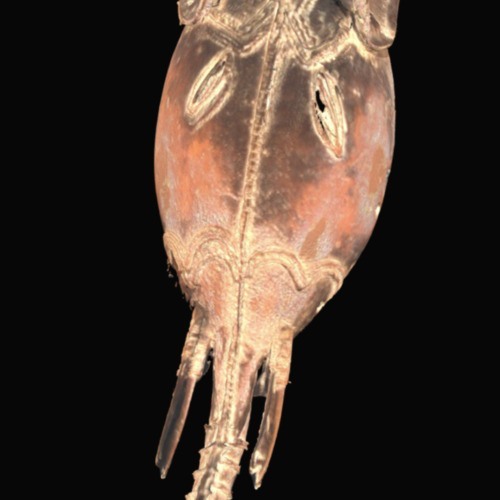
The Zamble mask of the Guro people embodies the intricate spirituality and social order of Ivory Coast societies. This ceremonial mask, used by the secretive Zamble society, represents a mythical being that is part animal and part human, a motif prevalent in Guro cosmology.
The mask’s elongated form, with its powerful jaws and pronounced snout, is characteristic of the noble elephant, while the graceful tusks suggest elegance and agility. The intricate scarification patterns adorning its surface are not mere decoration but are steeped in cultural significance, denoting courage, beauty, and ancestral lineage.
In the sacred dances, the Zamble mask becomes an animate entity, a mediator between the worlds of the living and the spirits. It is believed to possess the power to purify the village, to communicate with otherworldly beings, and to teach moral virtues through its dramatic presence.
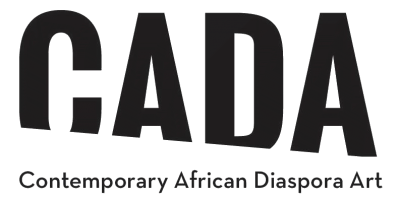
Leave A Comment